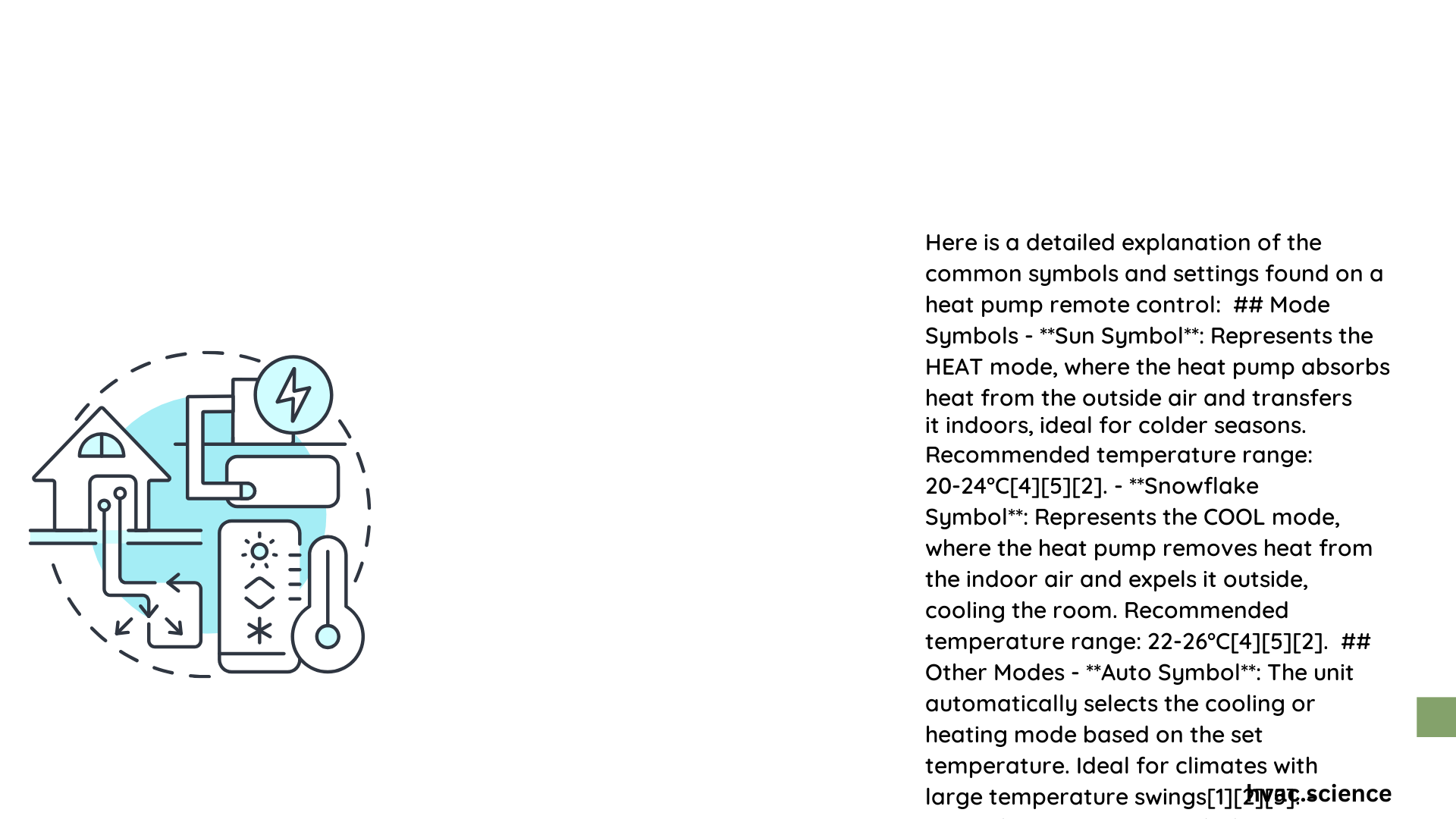Navigating the complex world of heat pump settings can be challenging for homeowners. Understanding the symbols on your control panel is crucial for optimal performance, energy efficiency, and comfort. This comprehensive guide will demystify the various icons, modes, and settings, empowering you to take full control of your heating and cooling system.
What Are the Basic Mode Indicators?
Heat pumps typically feature several fundamental mode indicators that help users control their indoor climate:
Cool Mode Symbols
- Snowflake Icon: Represents cooling function
- Temperature Range: 16°C to 32°C
- Ideal Use: Removing excess heat during warm seasons
Heat Mode Symbols
- Sun Icon: Indicates heating function
- Optimal Temperature Range: Outdoor temperatures between -15°C and 21°C
- Purpose: Absorbing external heat to warm indoor spaces
Auto Mode Functionality
| Symbol | Description | Key Benefit |
|---|---|---|
| Automatic Switch | Selects between cooling and heating | Maintains consistent room temperature |
| Temperature Adaptive | Adjusts mode based on set temperature | Energy-efficient operation |
How Do Fan Settings Work?

Fan settings play a critical role in heat pump performance:
- Fan Blade Icon
- Represents fan speed control
- Multiple speed levels available
-
Some units offer automatic fan speed adjustment
-
Airflow Direction Symbols
- Vertical and horizontal airflow adjustment
- Enables precise air distribution
- Improves overall room comfort
What Are Additional Operational Modes?
Dry Mode Functionality
- Teardrop/Water Symbol
- Reduces room humidity
- Lowers indoor fan speed
- Extracts moisture from air
- Cannot typically adjust temperature
Ventilation Mode
- Provides air circulation
- Often used with Heat Reclaim Ventilators
- Improves indoor air quality
How to Interpret Temperature and Energy Symbols?
Temperature Control
- Up/Down Arrow Buttons
- Precise temperature adjustment
- Typically labeled “TEMP”
- Incremental temperature changes
Energy-Saving Indicators
- Lock Symbol: Prevents accidental setting changes
- Timer Icons: Schedule temperature control
- Setback Symbol: Manages energy-efficient temperature levels
What Challenges Might Users Encounter?
Common Misunderstandings
- Confusing sun and snowflake symbols
- Incorrect mode selection
- Inefficient temperature settings
Performance Optimization Tips
- Use auto mode for adaptive temperature control
- Adjust fan speeds strategically
- Understand temperature range limitations
Technical Considerations for Efficient Operation
Energy Efficiency Factors
- Mode selection impacts power consumption
- Fan speed affects overall system performance
- Precise temperature settings reduce unnecessary energy use
Maintenance Recommendations
- Regularly check control panel symbols
- Understand each mode’s specific function
- Monitor system performance
Advanced Symbol Interpretation
Signal and Error Indicators
- Transmission Symbol: Confirms remote signal receipt
- Invalid Operation Icon: Indicates communication or operational issues
Diagnostic Insights
- Symbols can provide preliminary system health information
- Some advanced units offer error code displays
Practical Application Strategies
User-Friendly Approach
- Learn symbols progressively
- Consult user manual for specific model details
- Practice adjusting settings systematically
Technology Integration
- Modern heat pumps offer smartphone app controls
- Digital interfaces provide more intuitive symbol representation
Professional Recommendations
Expert Insights
- Regular professional maintenance
- Annual system check-ups
- Stay updated with technological advancements
Continuous Learning
- Attend workshops
- Follow manufacturer guidelines
- Stay informed about heat pump technology
Conclusion
Understanding heat pump settings symbols transforms your interaction with the system, enabling more efficient and comfortable climate control.
